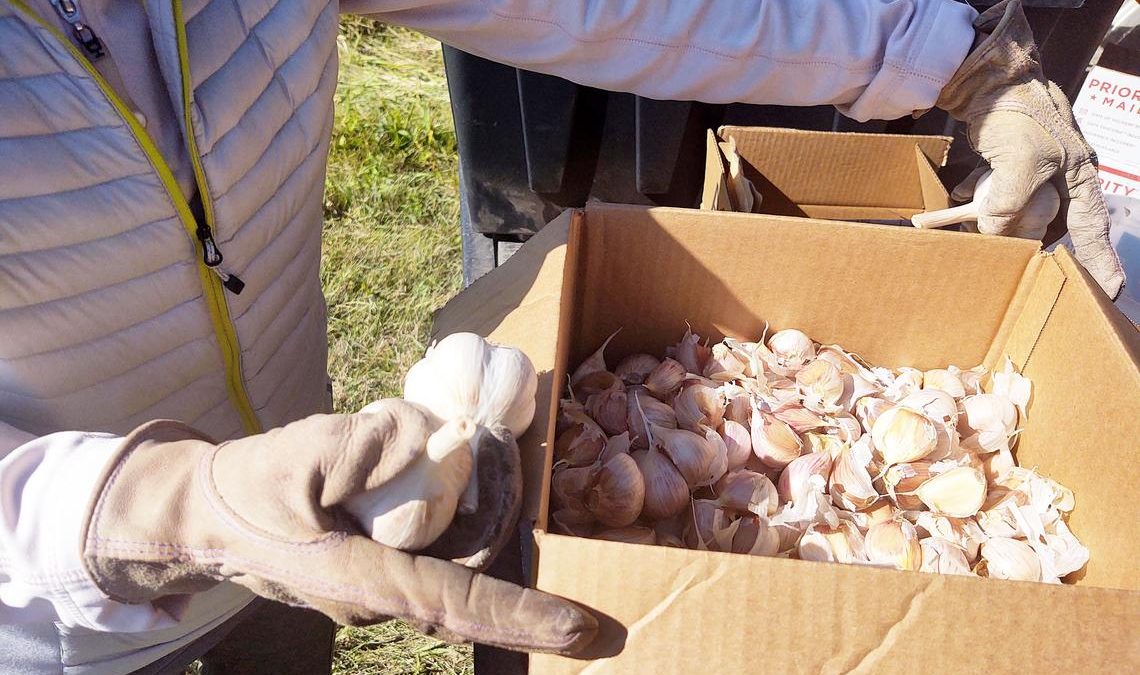
Winter is coming, and the restaurant owners all know it
October 14, 2020
Vision 2020: Will mailed-in ballots be delivered on time?
October 14, 2020It’s Rustic Roots Farm, which grows about the most vampire-proof crop around: garlic.
This fall marks the third consecutive year that owners Chad and Julie Olberding and their two kids, Leah, 12, and Blake, 10, have planted garlic, which is a bulb that is planted in the fall after a hard frost and is harvested the following summer.
They bought the small farm for their children, and hope sales of garlic, strawberries and hay will help pay for their college expenses some day.
“It’s a way for them to not only learn about stuff but it goes into their savings accounts,” Julie said.
Garlic is one of the specialty crops, along with asparagus, that Minnesota is encouraging as an additional source of income for growers in the state. Since 2017, the state has received nearly $4 million from the federal government through the Specialty Crop Block Grant Program. It has sent $173,500 of that to the Sustainable Farming Association to launch the Minnesota Garlic Project, which trains farmers in the best ways to grow and sell garlic. The nonprofit also received $58,000 to develop asparagus as a profitable crop.
“The bottom line is that garlic, especially certain types of garlic, can do really well — really well — in Minnesota,” said Jerry Ford, network coordinator and garlic trainer for the Sustainable Farming Association. “They thrive here. Garlic will store for months and you can keep on selling through the winter.”
The Olberdings ordered a box of seed garlic to try a new variety this year. (Karen Tolkkinen / Echo Press)
Garlic gets its own festival
Much of America’s grocery store garlic comes from California or China, Ford said, with China dominating the world garlic supply.
In California, four large growers dominate the garlic market, although he said Minnesota growers tend to keep their crops small. Garlic can get wiped out by freak acts of nature. In 2012, conditions created a “perfect storm,” with an early spring causing garlic to poke through the earth just in time for the jet stream to carry hordes of a tiny bug, the aster yellow leafhopper, into the state. They started chewing on the garlic stems and transferred a bacteria into the plant.
Growers had no idea anything was wrong until June, when green garlic stems, called scapes, shriveled and yellowed.
“There wasn’t much garlic to be sold that year,” Ford said.
A University of Minnesota plant pathologist, Dimitre Mollov, figured out what happened, and Ford said it took two more seasons to build back up.
The Olberdings said they know their garlic crop can fail. They have checked into insurance, but their premiums are so high it wasn’t worth it, Julie said.
Minnesota garlic differs from California garlic in that it’s designed for northern climates. Northern garlic tends to have a little less bite than southern garlic. Another key difference is the size of the cloves. They’re much bigger in northern garlic, which some cooks prefer because they don’t have to peel so many cloves.
“In some of the hardiest, most northern ones, there are only four cloves in a bulb,” Ford said.
Ford said he moved to Minnesota in 2002, married into a farming family, and wanted to start growing garlic. At the time, it was difficult to find Minnesota garlic growers so he bought his seed garlic from Wisconsin.
Unbeknownst to Ford, a professor named Joel Girardin grew more than 100 varieties of garlic in the 1980s and 1990s and kept meticulous records of his work. Girardin and Carl Rosen, head of the University of Minnesota’s Soil Science Department, found that Minnesota could produce garlic that had good flavor and stored well.
Then the work fell dormant until the Sustainable Farming Association decided to throw a party and call it the Minnesota Garlic Festival.
“It was almost a tongue-in-cheek thing,” said Ford, who has a background in theater. “People showed up in droves. All of a sudden garlic growers came out of the woodwork.”

Julie Olberding makes sure the garlic cloves are all facing the right way up. They are planted after a hard frost, develop roots throughout the fall, go dormant in the winter, and are harvested in July. (Karen Tolkkinen / Echo Press)
Nobody has an accurate number of how many Minnesota farmers are actually growing garlic. Ford said the association’s best count is that, in May 2018, there were 80 farmers growing garlic to sell and, in May 2020, 119 growers. He is mentoring 15 new garlic growers planting their first crop this spring.
Garlic sales in Minnesota fetch about $264,000 annually, which is a drop compared to the billions that crops like corn and soybeans bring into the state.
However, that cash is important for the families who grow garlic, Ford said.
“You’re probably not going to make that off rutabagas,” he said.
He can make $1.50 a pound for organic onions, he said, while garlic will bring in $10-$14 a pound.
But it’s also more difficult to grow than onions and the initial investment is more costly, he said.
Health food
The Olberdings plan to grow up to a half acre of nine different kinds of bulbs this year. Their crop sold out this year, and so they’re growing more — 225 pounds, up from 170 pounds last year. They sell to home cooks as well as co-ops and other growers. They’ve gotten most of their business off their Facebook page, but the Minnesota Garlic Project has helped, as has word of mouth.
Their varieties include popular varieties such as Music, Tamarack and Carpathian.
“Some of it was honestly what was available our first year,” Julie said. “We got into it a little late the first season. Since then we’ve added varieties that we think are interesting or would do well in our area.”
Besides its flavor, scholarly studies have indicated that garlic offers noticeable health differences. In 2000, researchers at Weill Medical College of Cornell University reviewed garlic studies and found evidence that it lowers bad cholesterol while preserving good cholesterol. They also found evidence that garlic slows atherosclerosis, lowers blood pressure, and has other cardiovascular benefits.
“Because garlic is a food and not a licensed medication, it cannot be marketed as a product intended to diagnose, treat, or prevent any illnesses,” the college announced at the time. “However, it clearly has a very low toxicity … and … together with other healthy dietary and lifestyle measures may safely be recommended to people seeking a heart-healthy diet.”
Those vampires
And about those vampires? Why do they fear garlic?
In 1998, Dr. Juan Gomez-Alonso, a Spanish neurologist, published a theory in the journal Neurology suggesting that 18th-century vampires were really people suffering from rabies.
Rabies causes hypersensitivity, which could explain why these so-called vampires avoided light and garlic.
The Olberdings’ crop is apparently keeping vampires away.
“We haven’t seen any of those in quite a number of years now,” Julie joked.







